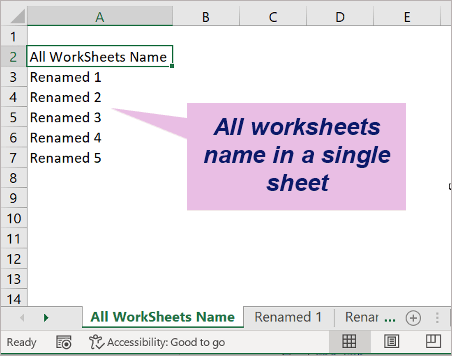5 Quick Ways to Rename Sheets in Excel

Managing and organizing data efficiently in Microsoft Excel involves much more than just inputting numbers and creating formulas. One often overlooked aspect of spreadsheet management is the ability to rename sheets, which can greatly enhance your productivity by making your Excel workbook clearer and more user-friendly. Here are five quick and effective methods to rename sheets in Excel, ensuring that your data management is as smooth as possible.
1. Using the Mouse

The most straightforward method to rename a worksheet involves your mouse:
- Double-click the sheet tab you wish to rename. A text box will appear where you can type the new name.
- Press Enter or click away from the tab to confirm the new name.
📝 Note: If you click too quickly or the double-click is not precise, you might end up activating the tab instead of editing its name.
2. Right-Click Context Menu

Another simple method to rename sheets is through the context menu:
- Right-click on the sheet tab.
- Select Rename from the dropdown menu.
- Type in your new sheet name and press Enter or click anywhere else to save.
3. Keyboard Shortcut for Speedy Users

If you're more comfortable with keyboard shortcuts, Excel has got you covered:
- Select the sheet you want to rename.
- Press Alt + H + O + R to initiate renaming.
- Type your new sheet name and press Enter.
⚡ Note: This shortcut works seamlessly in both Windows and macOS, making it universally useful.
4. Using VBA for Advanced Users

For those who automate tasks with Visual Basic for Applications (VBA), renaming sheets can be done programmatically:
- Press Alt + F11 to open the VBA Editor.
- Insert a new module (Insert > Module).
- Write the following code to rename a specific sheet:
Sub RenameSheet() Worksheets("Sheet1").Name = "NewName" End Sub - Replace "Sheet1" with the current sheet name and "NewName" with your desired name.
- Run the macro (Run Sub/UserForm).
💡 Note: This method is excellent for bulk renaming tasks, especially when dealing with many sheets.
5. Batch Renaming with a Custom Function

If you need to rename multiple sheets at once, a custom function can save you a lot of time:
- Open the VBA Editor (Alt + F11).
- Insert a module and add this function:
Sub BatchRenameSheets() Dim ws As Worksheet Dim newName As String Dim i As Integer i = 1 For Each ws In ThisWorkbook.Worksheets newName = "Sheet_" & i If ws.Name <> "Sheet1" Then ws.Name = newName i = i + 1 Next ws End Sub - Run the macro to rename all sheets sequentially.
These methods make renaming sheets in Excel a breeze. Whether you are working on a simple personal project or managing complex workbooks, the ability to quickly organize your tabs can lead to significant time savings and a cleaner, more organized data environment. Furthermore, employing these techniques can help in optimizing your workflow, making your Excel experience much more intuitive and effective.
Can I undo renaming a sheet in Excel?

+
Yes, Excel has an undo feature (Ctrl + Z) which can revert most actions, including renaming sheets. However, it is always safer to rename sheets deliberately to avoid mistakes.
Is there a limit to how many sheets I can have in one Excel workbook?

+
While Excel does not have a strict limit on the number of sheets, the practical limit depends on your system’s memory and processing power. Large workbooks with many sheets can become slow and cumbersome to work with.
What are some best practices for naming sheets in Excel?

+
When naming sheets, use clear and descriptive names to reflect the content. Avoid special characters, ensure names are unique, and consider using a naming convention or prefix for consistency and ease of understanding.



